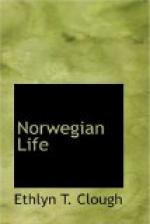But the world shall rise again and the dead come to life. From above comes the all-powerful one, he who rules everything, and whose name no one dares utter. All those who were virtuous and pure of heart will gather in Gimle in everlasting happiness, while the evil ones will go to Naastrand at the well Hvergelmer to be tortured by Nidhugger. A new earth, green and beautiful, shall rise from the ocean. The gods awake to new life and join Vidar and Vale, and the sons of Thor, Mode and Magne, who have survived the great destruction and who have been given their father’s hammer, because there is to be no more war. All the gods assemble on the field of Ida, where Asgard was located. And from Liv and Livthraser, who hid themselves in Ygdrasil during the burning of the world, a new human race shall descend.[d]
CHAPTER V
NORWEGIAN LITERATURE
The people who emigrated from Norway and settled in Iceland, after Harald the Fairhaired had subdued the many independent chiefs and established the monarchy (872), for the most part belonged to the flower of the nation, and Iceland naturally became the home of the old Norse literature. Among the oldest poetical works of this literature is the so-called “Elder Edda,” also called “Saemund’s Edda,” because for a long time it was believed to be the work of the Icelander Saemund. “The Younger Edda,” also called “Snorre’s Edda,” because it is supposed to have been written by Snorre Sturlason (born 1178, died 1241), contains a synopsis of the old Norse religion and a treatise on the art of poetry. Fully as important as the numerous poetical works of that period was the old Norse Saga-literature (the word saga means a historical tale). The most prominent work in this field is Snorre Sturlason’s Heimskringla, which gives the sagas of the kings of Norway from the beginning down to 1777. A continuation of the Heimskringla, to which several authors have contributed, among them Snorre Sturlason’s relative, Sturla Thordson, contains the history of the later kings down to Magnus Law-Mender.
The literary development above referred to ceased almost entirely toward the end of the fourteenth century, and later, during the union with Denmark, the Danish language gradually took the place of the old Norse as a book-language, and the literature became essentially Danish. Copenhagen, with its court and university, was the literary and educational center, where the young men of Norway went to study, and authors born in Norway became to all intents and purposes, Danish writers. But Norway furnished some valuable contributors to this common literature. One of the very first names on the records of the Danish literature, Peder Claussoen (1545-1614), is that of a Norwegian, and the list further includes such illustrious names as Holberg, Tullin, Wessel, Steffens, etc.




